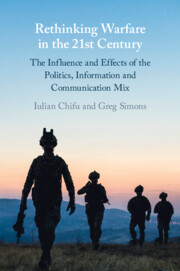 Rethinking Warfare in the 21st Century
Rethinking Warfare in the 21st Century Published online by Cambridge University Press: 29 June 2023
The manner in which armed conflicts are catagorised is an important feature of the politics of warfare. There are different implications and aspects of symbolism whether a conflict is categorised as being a civil war or a geopolitical shatterbelt. This is of relevance and significance for foreign sponsors and patrons of the conflict as terminology is useful in determining how different audiences perceive and react to the conflict in question. This chapter explores the rhetorical categorisation of the conflicts in Syria and Ukraine in terms of the narratives and storytelling used to engineer opinions, perceptions and responses to these conflicts.
To save this book to your Kindle, first ensure [email protected] is added to your Approved Personal Document E-mail List under your Personal Document Settings on the Manage Your Content and Devices page of your Amazon account. Then enter the ‘name’ part of your Kindle email address below. Find out more about saving to your Kindle.
Note you can select to save to either the @free.kindle.com or @kindle.com variations. ‘@free.kindle.com’ emails are free but can only be saved to your device when it is connected to wi-fi. ‘@kindle.com’ emails can be delivered even when you are not connected to wi-fi, but note that service fees apply.
Find out more about the Kindle Personal Document Service.
To save content items to your account, please confirm that you agree to abide by our usage policies. If this is the first time you use this feature, you will be asked to authorise Cambridge Core to connect with your account. Find out more about saving content to Dropbox.
To save content items to your account, please confirm that you agree to abide by our usage policies. If this is the first time you use this feature, you will be asked to authorise Cambridge Core to connect with your account. Find out more about saving content to Google Drive.